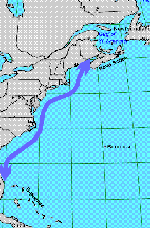 |
 |
 |
 |
 |
 |
 |
Right Whale Migration Update: March 17, 1999
Today's Report Includes:
- Right Whale Sightings in Northern Waters
- Discussion of Challenge Question #6: Going in Circles?
- Discussion of Challenge Question #7
- Living to a Ripe Old Age: Challenge Question #8
Right Whale Sightings in Northern Waters
3/10/99
- 16 whales in a 8.9 nautical mile radius from 41.97 N, 70.20 W
- 1 whale in a 2.7 nautical mile radius from 41.08 N, 71.05W
- 2 whales (mother and calf) in a 2.7 miles radius from 40.80 N, 72.52W.
3/14/99
- 11 whales in a 3.2 nautical mile radius from 41.59N, 70.13W
- 10 whales in a 2.7 nautical mile radius from 41.87N, 70.14W.
Again, there were no sightings from the southern grounds.
Discussion of Challenge Question #6: Going in Circles?
In my last report I asked why the Right Whale Sighting Coordinator would report findings with a radius around a point, rather than just listing the latitude and longitude on the Alerts. The answer is: "The whales move constantly, and we don't know where they are going to show up next." Although right whales may feed at one location for some length of time, this is not something that can be expected all the time. Just as horses graze over a pasture, whales "graze" on copepod patches that interest them. How they find them, and why they shift positions, is not understood. The circle provides mariners (people at sea) with a general idea of where the whales are and where they should be especially careful to keep watch.
Discussion of Challenge Question #7
 My other Challenge Question was about whale longevity. Whale #1045 is one
whale with a very long sighting history. She was first seen in 1935 with a calf. The last sighting was in 1995.
Right whales can have a calf at the minimum age of 5 -- so, if this was her first calf, then the youngest #1045
could be is 65 (in 1995).
My other Challenge Question was about whale longevity. Whale #1045 is one
whale with a very long sighting history. She was first seen in 1935 with a calf. The last sighting was in 1995.
Right whales can have a calf at the minimum age of 5 -- so, if this was her first calf, then the youngest #1045
could be is 65 (in 1995). But right whales average a calf every 3-5 years, and if this was not her first calf, she could be many years older than that. Plus, most right whales don't have their first calf until age 9 or older. Amy Knowlton at the New England Aquarium's Right Whale Group told me that many scientists believe that these whales might be able to live to ripe old ages of 100 or more!
Challenge Question #8
"What factors might prevent whales from reaching this ripe old age of 100? What might be some of the causes of mortality other than old age?"
Here's hoping we get a sighting of a mother-calf pair up here and an identification. It would be nice to know
if this is a pair that was spotted down south--or hopefully one that avoided earlier detection. With such a small
birth rate this year, any additional calves would be greatly welcomed.
That's all for now. This is Anne Smrcina, education coordinator of the Stellwagen
Bank National Marine Sanctuary, signing off.
How to Respond to Today's Challenge Question:
1. Address an E-mail message to: jn-challenge-rwhale@learner.org
2. In the Subject Line of your message write: Challenge Question #8
3. In the body of your message, answer the question above.
The Next Right Whale Migration Update will Be Posted on March 31, 1999.
Copyright 1999 Journey North. All Rights Reserved. Please send all questions, comments, and suggestions to our feedback form
 |
 |
 |
 |
 |
 |

